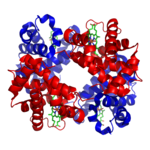
Heterotetramer
Encyclopedia

Homotetramer
A homotetramer is a protein complex made up of four identical subunits which are associated but not covalently bound. A heterotetramer is a 4-subunit complex where one or more subunits differ....
contains four identical subunits.
Examples include haemoglobin (pictured), the NMDA receptor
NMDA receptor
The NMDA receptor , a glutamate receptor, is the predominant molecular device for controlling synaptic plasticity and memory function....
, some aquaporin
Aquaporin
Aquaporins are proteins embedded in the cell membrane that regulate the flow of water.Aquaporins are integral membrane proteins from a larger family of major intrinsic proteins that form pores in the membrane of biological cells....
s, some AMPA receptor
AMPA receptor
The α-amino-3-hydroxy-5-methyl-4-isoxazolepropionic acid receptor is a non-NMDA-type ionotropic transmembrane receptor for glutamate that mediates fast synaptic transmission in the central nervous system . Its name is derived from its ability to be activated by the artificial glutamate analog AMPA...
s, as well as some enzyme
Enzyme
Enzymes are proteins that catalyze chemical reactions. In enzymatic reactions, the molecules at the beginning of the process, called substrates, are converted into different molecules, called products. Almost all chemical reactions in a biological cell need enzymes in order to occur at rates...
s.

